Bachata (dance)
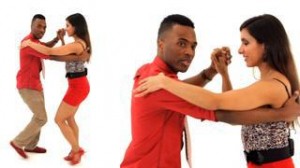
What Is Bachata?: Bachata Dance
Edwin: What is bachata? Well, a beautiful dance from the Dominican Republic. Bachata is dated back to the early 20th century. It derived from the bolero, which is from Cuba, imported into the Dominican Republic. Very similar instrumentation, but the only difference then is instead of maracas, they have the güira. The music is very similar. It was known as bolero campesino, which is like peasant bolero. And then, little by little, more people started to play it in the rural towns, and it started to grow. And it became musica amargue. The music itself is just very straightforward. The words are always more about bitterness and heartbreaks, and women needing the guys, and pain, someone losing someone, or someone cheating. It’s always very sad. But the way that we dance it, we reflects kind of like how we let out the steam. How do we cope with it? And we cope with it through dancing. Bachata has traveled a lot around the world now, and it’s pretty much a popular dance style now, and a lot of people are starting to learn more and more about it. And the way that we dance it is just amazing. Very interactive. Daniela: The way that we dance bachata is with a four-step timing. We go: one, two, three, tap. Five, six, seven, tap. We’re always tapping on the four and the eight. Bachata at the beginning was very traditional, of course. Traditional bachata used to be danced just in the center, going forward and back. Very basic steps. Now it has fused into different salsa bachata and tango bachata, and different styles put into bachata, which is very nice to see, like modern and urban bachata, and stuff like that. Edwin: Right. I guess with the different additions into bachata, the evolution of it is pretty much what has kept it around for so long. People in Europe took on bachata, and they mastered it and started to fuse it with things that they know. I would say it’s very interesting to see where bachata’s going to go, with everyone all over the world learning more and more about it. I guess it’s always good to appreciate the traditional, but also to keep an open mind and try out different things. I’m very curious to see where bachata goes in the future, but I would like everyone to actually read more about bachata and learn about it. It’s a very beautiful dance.
 Bachata is a style of dance that originated in the Dominican Republic. The basics to the dance are three-steps with a Cuban hip motion, followed by a tap which can include a hip movement also on the 4th beat. It is danced widely all over the world but not identically.
Bachata is a style of dance that originated in the Dominican Republic. The basics to the dance are three-steps with a Cuban hip motion, followed by a tap which can include a hip movement also on the 4th beat. It is danced widely all over the world but not identically.
Description
The basic bachata step consists of a horizontal, three-step movement, with steps on each beat of the music, followed by a tap on the fourth beat. The hips are often emphasized in bachata, and the knees should be slightly bent so the performer can sway their hips easier. Generally, most of the dancer’s movement is in the lower body up to the hips, and the upper body can be moved more or less.
In partnering, the lead can decide whether to perform in open or closed position. Dance moves, or step variety, during performance strongly depends on the music (such as the rhythms played by the different instruments), setting, mood, and interpretation. Unlike Salsa, Bachata dance does not usually include complex turn patterns but they are used more and more as the dance evolves. The leading is done just like in most other social dances, with a “pushing and pulling” hand and arm communication. Hand and arm communication is better conveyed when most of the movement is performed by the lower body (from waist down); i.e. hips and footwork.
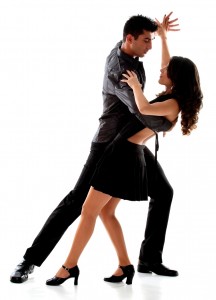 The original dance style from the Dominican Republic in the Caribbean is a basic dance sequence in a full 8 count moving within a square. Dancers in the Western World much later began developing a more simple pattern and added dance elements from other dances as well, the basic is also in a full 8 count, but with a side-to-side motion. Both Styles consist of 3 steps normal and then a tap step. The tap is often accompanied by a “pop” of the hips, and is sometimes substituted with syncopations (steps in between the beats). Bachata music has an accent (the Bass) in rhythm at every fourth count. Often, this is when dancers will tap-step & pop their hips – this is called dancing bachata to the basic rhythm of the music (because the first step after the pop falls on the 1st beat of the measure). But bachata can be danced to different timings as well if it’s danced to one particular instrument instead. The tab or ‘pop’ is done in the opposite direction of the last step, while the next step is taken on the same direction as the tap or pop. The dance direction changes after the tap or fourth step. There are several bachata styles.
The original dance style from the Dominican Republic in the Caribbean is a basic dance sequence in a full 8 count moving within a square. Dancers in the Western World much later began developing a more simple pattern and added dance elements from other dances as well, the basic is also in a full 8 count, but with a side-to-side motion. Both Styles consist of 3 steps normal and then a tap step. The tap is often accompanied by a “pop” of the hips, and is sometimes substituted with syncopations (steps in between the beats). Bachata music has an accent (the Bass) in rhythm at every fourth count. Often, this is when dancers will tap-step & pop their hips – this is called dancing bachata to the basic rhythm of the music (because the first step after the pop falls on the 1st beat of the measure). But bachata can be danced to different timings as well if it’s danced to one particular instrument instead. The tab or ‘pop’ is done in the opposite direction of the last step, while the next step is taken on the same direction as the tap or pop. The dance direction changes after the tap or fourth step. There are several bachata styles.
Dominican Bachata
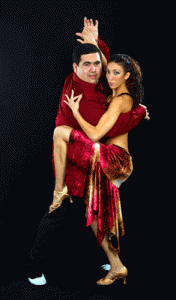 The Dominican Bachata dance style is the original style of Bachata, originating from the Dominican Republic where the music also was born. The early slow style in the sixties from where everything started was danced only closed, like the Bolero. The Bachata Basic Steps moving within a small square (side, side, forward and side, side, back) are also inspired from the Bolero but danced slightly different including a tap and also syncopations (steps in between the beats) depending on the dynamics of the music being played. The hand placement will vary with the dancers position which can be very close to semi-close to open.
The Dominican Bachata dance style is the original style of Bachata, originating from the Dominican Republic where the music also was born. The early slow style in the sixties from where everything started was danced only closed, like the Bolero. The Bachata Basic Steps moving within a small square (side, side, forward and side, side, back) are also inspired from the Bolero but danced slightly different including a tap and also syncopations (steps in between the beats) depending on the dynamics of the music being played. The hand placement will vary with the dancers position which can be very close to semi-close to open.
The Dominican style is today danced all over the Caribbean, now also faster in accordance to faster music, adding more footwork, turns/figures and rhythmic free style moves and with alternate between close (romantic) and open position (more playful adding footwork, turns/figures, rhythmic torso etc.). This style is danced with soft hip movements and a tap with or without a small “pop” with the hip on the tab (1, 2, 3, Tab/Hip). Can be danced with or without bounce also (moving the body up on the beats and down again in between the beats by springs the legs a little). Dominican Bachata is created by the people over many years (from around the beginning of the sixties) for social dancing and are the day today still evolving.
Notice that what’s called Dominican Bachata in the West is just called Bachata in The Dominican Republic and by most Dominican immigrants. Dominican Bachata is the original style of Bachata and therefore by some also called the traditional style. Because of this, the name “Traditional Bachata” for the first not very old Fusion Style Bachata is misleading; nevertheless it is term of today.
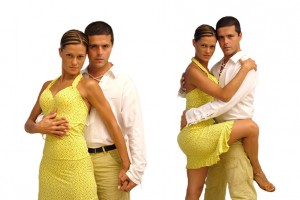 Traditional (the Western Traditional: As mentioned the first Fusion Style)
Traditional (the Western Traditional: As mentioned the first Fusion Style)
At some point in the late 1990s, dancers and dance-schools in the Western World began using a simpler side to side pattern instead of the box-steps probably due to a misunderstanding of the original steps. The basic steps of this pattern move side to side, changing direction after every tap. Characteristics of this “early” dance school style is the close connection between partners, soft hip movements, tap with a small “pop” of the hip on the 4th step (1, 2, 3, Tap/Hip) and does not include many Turns/Figures. Most of the styling in this style is from Ballroom Dance and Dips are commonly used in this style. This was the first style of Bachata popularized by salsa schools outside the Dominican Republic.
Modern/Moderna (later Fusion Style)
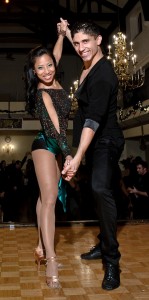 Later a newer style called Modern Style was developed probably from around 2005 on the ‘Traditional’ Style base. This style is widely considered to have originated in Spain, but as with all ‘evolutions’ of dance style this itself is widely debated. The basics are the same as Traditional Style Bachata, but with added dance elements and styling from Salsa, Tango, Zouk-lambada, Ballroom etc. In this style, couples typically move their upper torsos more, put greater emphasis on the hip pop, and women use more exaggerated hip movements. The most direct fusion influence on modern style bachata dancing comes from the adoption of salsa turn patterns. There is also an even newer modern Urban Style that incorporates HipHop elements but this style basically also have the same technical base as Modern Style.
Later a newer style called Modern Style was developed probably from around 2005 on the ‘Traditional’ Style base. This style is widely considered to have originated in Spain, but as with all ‘evolutions’ of dance style this itself is widely debated. The basics are the same as Traditional Style Bachata, but with added dance elements and styling from Salsa, Tango, Zouk-lambada, Ballroom etc. In this style, couples typically move their upper torsos more, put greater emphasis on the hip pop, and women use more exaggerated hip movements. The most direct fusion influence on modern style bachata dancing comes from the adoption of salsa turn patterns. There is also an even newer modern Urban Style that incorporates HipHop elements but this style basically also have the same technical base as Modern Style.
Bachatango/Bachata Tango (later Fusion Style)
 At the same time as the Modern Style was developed there was also developed an another style called Bachatango/Bachata Tango. It’s also a Fusion Style from the West with short sequences of Traditional basic steps and then added different Tango steps danced like Tango. The “pop” count is used to add elaborated sensuality and varied Latin dance styles and also include the characteristic kicks from Tango. The Vueltas is like the Traditional Style. Although this dance has been used to dance to Bachata, it has evolved to be used to dance to Tango as well. Even though BachaTango is unheard of in the Dominican Republic, Bachata’s country of origin, BachaTango has become popular with foreign instructors outside the Caribbean.
At the same time as the Modern Style was developed there was also developed an another style called Bachatango/Bachata Tango. It’s also a Fusion Style from the West with short sequences of Traditional basic steps and then added different Tango steps danced like Tango. The “pop” count is used to add elaborated sensuality and varied Latin dance styles and also include the characteristic kicks from Tango. The Vueltas is like the Traditional Style. Although this dance has been used to dance to Bachata, it has evolved to be used to dance to Tango as well. Even though BachaTango is unheard of in the Dominican Republic, Bachata’s country of origin, BachaTango has become popular with foreign instructors outside the Caribbean.

